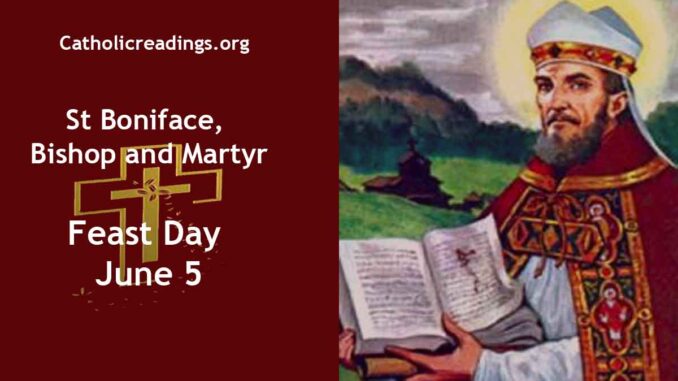St Boniface, Bishop and Martyr was also called Boniface of Crediton, Apostle of Germany, Boniface of Mainz, Winfrid, Winfried or Wynfrith.
He was born in 675 AD in Crediton, Devon, England and died on June 5 754 at Dokkum, Freisland now in modern-day Netherlands).
His feast day is celebrated on June 5 every year.
| St Boniface, Bishop and Martyr Biography | |
|---|---|
 St Boniface, Bishop and Martyr – Feast Day – June 5 2026 | |
| Date of Birth | 675 AD |
| Place of Birth | Crediton, Devon, England |
| Profession | Bishop |
| Place of Work | Frisia, Netherlands and Germany |
| Date of Death | June 5 754 |
| Place of Death | Dokkum, Frisia, Netherlands |
| Feast Day | June 5 |
| Canonization | Pre-Congregation |
| Patron Saint of |
|
St Boniface Life History
St Boniface hailed from a respected and prosperous family and against his father’s will, he joined the monastic life from an early age.
Later, he received further theological training from both the minister of Nhutscelle and the Benedictine monastery of Exminster near Winchester.
St Boniface began to teach in the abbey school and became a priest at the age of 30.
Around 716 AD, Abbot Wynberth of Nursling died, and St Boniface was expected to take over that position but he declined. Instead, he started his missionary expedition to Frisia.
St Boniface travelled to Utrecht and met Willibrord who had been there working since the 690s. He stayed there for around a year but the war between Charles Martel and Radbod, King of the Frisians frustrated their efforts.
Willibrord fled to Echternach now in modern-day Luxembourg, to the abbey he had founded and Boniface returned to Nursling.
After a year St Boniface left to evangelize but this time went straight to Rome. It is in Rome that Pope Gregory II renamed him from Winfrid to “Boniface”, after the fourth-century martyr Boniface of Tarsus.
The pope appointed him the missionary bishop for Germania, a place where there was no existing diocese or any church organization.
In Saxony, St Boniface met a native tribe worshipping a Donar Oak Tree, near the present-day town of Fritzlar in northern Hesse.
When he started to chop down the oak tree with an axe, miraculously a great wind blew the ancient oak over.
He stood on the tree trunk and asked, “How stands your mighty god? My God is stronger than he.” When the gods did not strike him down, the people started to convert to Christianity.
St Boniface used the wood from that oak tree to build a chapel dedicated to Saint Peter. That chapel marked the beginning of the monastery in Fritzlar. Later on in the same spot a church with an attached monastery was built in Fritzlar.
St Boniface travelled again to Rome in 732 AD and Pope Gregory III made him the archbishop with jurisdiction over Germany.
As an archbishop, he continued with his mission, and during his third visit to Rome in 737–38, he was made papal legate for Germany.
After Boniface’s third trip to Rome, Charles Martel (a Frankish statesman and military leader who was the ruler of Francia) helped to establish four dioceses in Bavaria namely Passau, Salzburg, Freising and Regensburg. He gave them to Boniface as archbishop and metropolitan over all of Germany east of the Rhine.
Charles Martel was so instrumental in St Boniface’s work such that Boniface told Daniel of Winchester, his long-time friend, that he could “neither administer his church, defend his clergy, nor prevent idolatry” without the protection of Charles Martel.
In his quest to continue converting the Frisians, St Boniface, in 754 AD, set out to do his work and baptized many.
He later called for a general meeting for confirmation at a place between Franeker and Groningen not far from Dokkum and instead of his converts coming, armed pagan robbers showed up and slew him to death.
It is said that St Boniface persuaded those who were with him not to fight with the armed robbers but to Cease fighting and lay down their arms, for the Holy Scripture says,” Do not to render evil for evil but to overcome evil by good.”
St Boniface Feast Day
The Roman Catholic Church celebrates Saint Boniface’s feast day on June 5 every year.
Relics
St Boniface’s remains were moved from the Frisian countryside to Utrecht, and then to Mainz but eventually, they were buried in the abbey Church of Fulda and are entombed within a shrine beneath the high altar of Fulda Cathedral.
Major Shrines, Churches, Cathedrals, Basilicas, or Sanctuaries Named After Saint Boniface
There is a famous statue of Saint Boniface that stands on the grounds of Mainz Cathedral which is the seat of the archbishop of Mainz.
A modern statue also stands facing Saint Peter’s Catholic Church and Minor Basilica.
St Boniface’s Catholic College, Plymouth, England was founded by Bishop George Errington in 1856.
In 1818, Father Norbert Provencher founded a mission and built a log church and named it after St. Boniface.
The church was later consecrated as Saint Boniface Cathedral and the community that expanded around the cathedral eventually became the city of Saint Boniface, now part of the city of Winnipeg.
St Boniface is the Patron Saint of
- Fulda;
- Germania;
- England (Orthodox Church;
- Brewers
- File cutters
- Tailors
- Archdiocese of Saint-Boniface, Manitoba, Canada
- Diocese of Fulda, Germany
Today’s Catholic Quote:
Saint Boniface, Bishop and Martyr teaches us how the love of Christ changes all things. It was for Christ’s sake that he toiled for souls, preferring poverty to riches, labour to rest, suffering to pleasure, death to life, that by dying he might live with Christ.
Related Links
Powered By SEO Experts
Follow @ReadingCatholic
